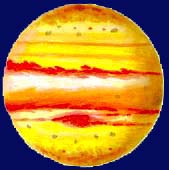Jupiter
- Diameter is 88,700 miles (142,700 km); more than 11 times that of earth.
- Distance of 483,700,000 miles (778.3 million km) from the sun
- Average temperature is -234°F (-148°C)
- Jupiter has sixteen moons:
- Four of the smaller moons orbit in the opposite direction of the rest.
- The four largest moons are known as the Galilean moons:
- Gandymede
is dark with heavily cratered areas, grooved terrain and a system of faults.
- Callisto
is the most distant of these four.
- Equatoral diameter is 88,700 miles (142,700 km).
- Polar diameter is 82,900 miles (133,400 km).
- Europa
is about the same size as earth's moon.
- It is the second closest of these four to the planet.
- Very smooth surface criss-crossed by long streaks.
- Io
is the closest of these four to Jupiter.
- About the same size as earth's moon.
- Yellow to orange surface; probably composed of sulfur and sulfur compounds.
- Has active, violent volcanoes.
- All non-Galilean moons are very small.
- Rotation:
- At equator -- 9 hours 50 minutes.
- At poles -- 9 hours 55 minutes.
- Revolution takes 11.8 years (11 years, 314.96 days).
- Density is 1.3 times that of water.
- Mass is more than 2 times that of all 8 of the other planets combined.
- Jupiter appears as a bright starlike object in the night sky.
- Planet comprised of:
- A solid earth-sized core.
- Layer of hot liquid hydrogen and helium about 40,000 miles (64,000 km) thick.
- Noticeable bulge at equator.
- It radiates 2-3 times the amount of heat it receives from the sun.
- Interior heat may range to 54,000°F (30,000°C).
- Tremendous atmospheric pressure.
- Atmosphere of hydrogen and helium and traces of water, ammonia and ammonium hydrosulfide.
- Outermost portion of atmosphere displays distinctive series of light and dark cloud bands parallel to the planet's equator.
- Apparent cause is the rising and falling of the hot gases.
- Bands vary in color and occasionally display spots and other markings.
- Stronger magnetic field than earth.
- Traps high-energy magnetic particles from the sun.
- Immense magnetosphere which is a source of radio-wave transmission.
- Encircled by a faint ring.
- The largest of the planets in the solar system, more than 1,300 Earths could fit inside it.
|




